What if I told you that you never needed to water, fertilize, reseed or mow another lawn? Would that appeal to you? It really appealed to me, so seven years ago I looked into a xeriscape design for my small backyard. I loved it so much that four years later I found a design for my front yard.
This post will explain what xeriscape is and why you might find it desirable for your home’s landscape. I will also showcase the steps I went through with my front yard and then provide some free resources if you want to consider trying it in your yard or even just a small section of it.
What is Xeriscape?
Xeriscape is a term that was derived from the Greek word xeros, meaning “dry,” in 1981 by the Denver Water Company. Its literal definition is “dry landscape.” According to the Denver Water Company website, “A well-designed xeriscape can be a beautiful addition that can invite wildlife, provide year-round interest and save water.”
The term xeriscape is used to describe a landscape designed using a system of important principles that work together to use less water than lawns. The important principles include:
-
- Designing a landscape that accounts for water drainage, sun exposure and soil types.
- Evaluating soil and adding amendments, if needed.
- Using irrigation efficiently by grouping plants accordiing to watering needs.
- Designing a water efficient irrigation system, so that each plant receives the water needed with drip irrigation rather than overhead.
- Using mulch to keep soil moist longer.
Xeriscape generally relies on using plants native to the area. This benefit generally helps with the need for minimal supplemental irrigation, plants that can cope with changes in temperature and that will resist disease and pests. It often includes rocks, which serve as a form of mulch as well as provide texture and color. A xeriscape design can include grass areas, but the plans I have in my front and back yard do not include any grass that requires mowing.
How I Started
While walking my usual neighborhood route a few years ago, I became intrigued by one particular yard. Besides having a beautiful collection of rocks, plants and garden art, it contained a sign saying it was a “Certified Wildlife Habitat!” I had never seen a sign like this and promptly wrote down the web address to look into it further.
On a later walk, I knocked on the door to speak to the homeowners about their design, plants, and the wildlife habitat sign. They were very friendly and also showed me their backyard which was even larger and more beautiful than their front yard! Lisa pointed me in the direction of several books and websites for xeriscape designs and plant choices, which I will be sharing with you at the end of this post. Since that meeting, we have exchanged plant clippings and I even helped Lisa finish a sewing project. Funny how much we often have in common with strangers. I am glad I had taken a risk and knocked on their door.
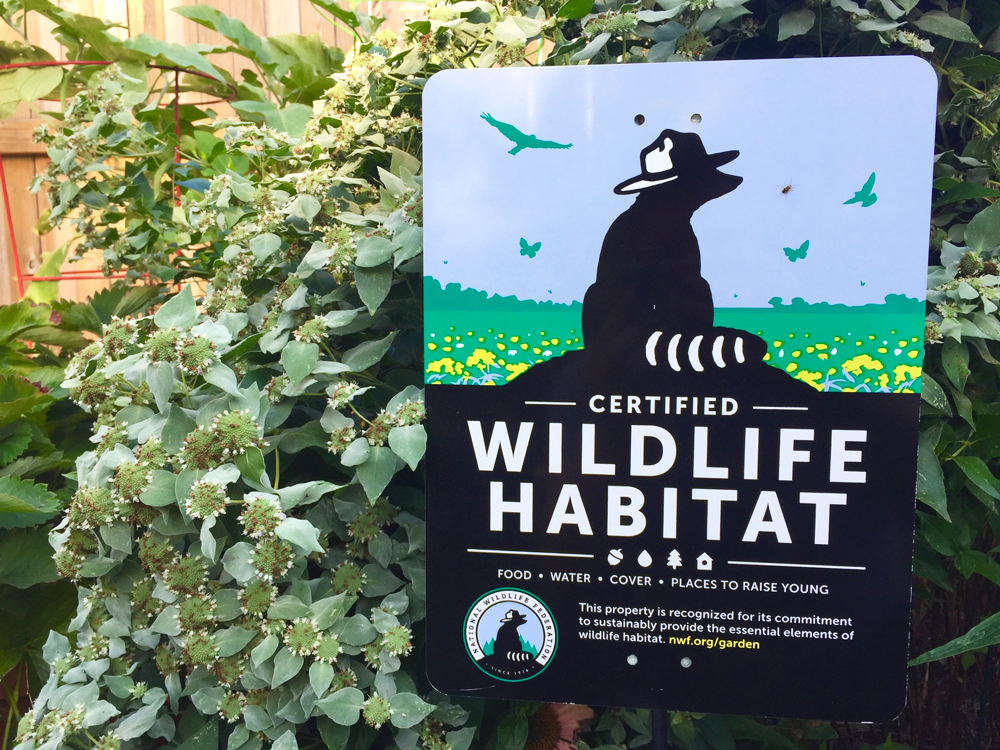

As with the rest of the homes on my block, my yard consisted of a small patch of grass, a small tree and a five plants. I didn’t want a tree in my yard since I have solar panels on my roof. It was a small tree, but I didn’t want any shading for the panels. Fortunately, a neighbor’s tree had died and she was looking to replace it. We were able to make arrangements with my contractors to move it to the large hole in her yard. I was so happy that the tree ended up with a new home instead of going to landfill.
After researching the types of drought resistant plants I wanted, my friend Jan offered to create a design for my yard. In one of her prior careers, she owned a landscaping design business. It was great to see it on paper, but more exciting going to a plant nursery to see what the plants looked like. Once I hired someone to do the hardscaping, irrigation, planting and mulching, I tried to wait patiently for the plants to show their beauty. The problem with purchasing smaller (more affordable) plants is the time required to see them in bloom is much longer. But it eventually happened. Each season my yard now has many dimensions and there is something new to see.
Creating a Haven for All of Your Senses
Many of the resources I list at the end reference which plants attract birds, bees and butterflies. The descriptions also mention what colors the plant displays and during which season. Get creative and find plants that can create a treat for as many senses as possible! The joy you will experience is can’t be described adequetly in print. If possible, include a bench or small table with chairs to sit and observe, read, drink tea…
Visual Appeal
The blending of colors from plants, rock, mulch and art can create visual art in your yard. It is fun to get creative with artistic nuances. In Lisa’s yard, she has a “river” made from rock. She then installed several metal stakes that have metal fish on them throughout the “river.”


Plants in photo collage clockwise: 1) Russian sage; 2) Rosemary; 3) Mint; 4) Lavender; 5) Creeping thyme in my walking path.
Aromatics
Purposefully placed aromatic plants are my favorite addition to my garden. I planted creeping thyme and chamomile in my walking paths. Everytime I step on the plants I am rewarded with soothing fragrances.
Rosemary is a vibrant plant. It adds flavor to foods and drinks and adds aroma to a garden when running your hand along a branch.
Mint is such a refreshing smell but if you decide to plant mint anywhere, I recommend planting it in a pot. Mint spreads easily and can take over a whole area.
I have recently decided that lavender is my favorite plant. Whenever I brush against it or run my fingers over the purple stalks, I am rewarded with a calming fragrance. Purple is my favorite color, which cinches lavender as my perfect plant!
Taste
As my prior blog about gardening mentions, I treasure the experience of harvesting food, herbs and flowers from my yard. Herbs such as thyme, mint, parsley, chives, rosemary, lavender, sage, etc. can be grown in your garden, yard or in pots. I get the best tasting raspberries from the vines planted along my backyard fence.
I haven’t grown sunflower seeds for harvesting in many years, but it was fun to watch the plant grow to towering heights. The trick is keeping birds and squirrels away from the seeds by covering the head with netting.
Plants in photo collage clockwise: 1) Chamomile; 2) Lavender; 3) Sunflower seeds; 4) Raspberries; 5) Rosemary
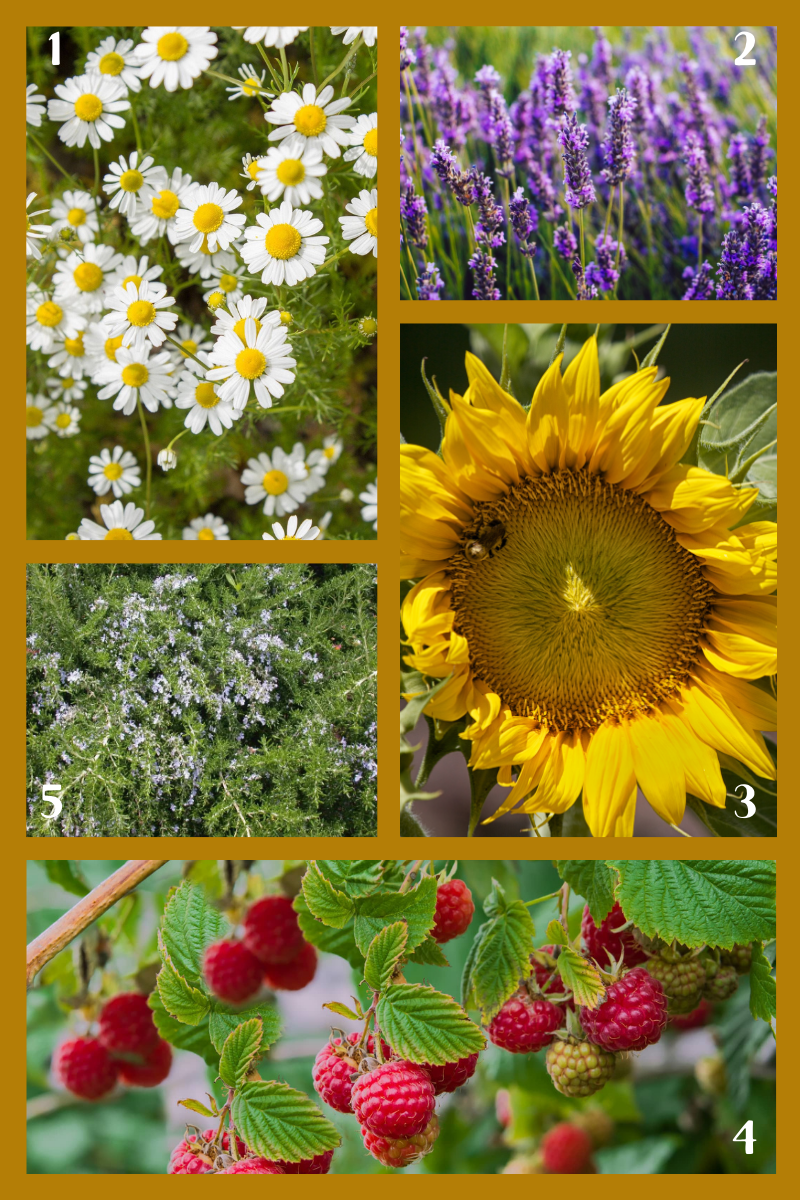
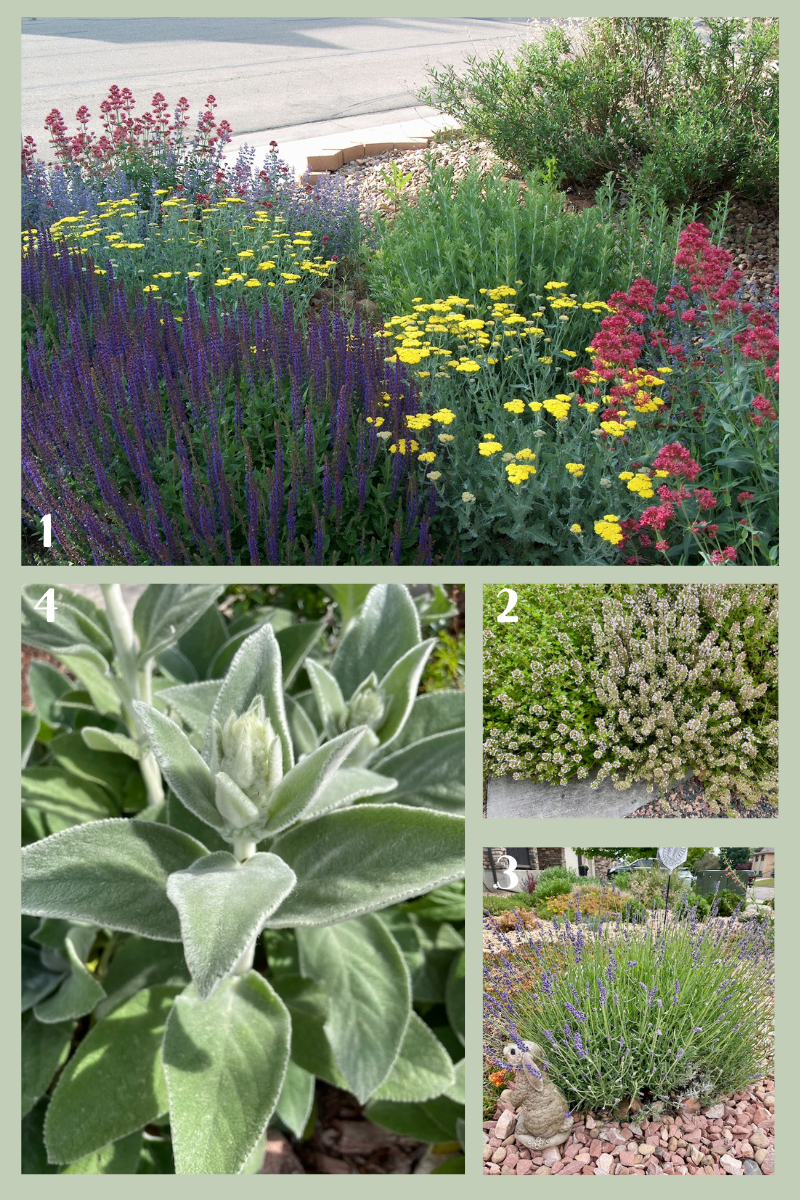
Touch
Running my hand through plant stalks and oft fountain grasses is a relaxing activity I do. If a water feature is in your yard, dipping your fingers in it can be cooling. Sitting on a bench warmed by the sun, swinging in a hanging chair or resting in a hammock are other ways I activate my sense of touch in my yard. No matter how many times I touch it, I can’t walk past a lamb’s ears plant without touching the soft, silky leaves.
Plants in photo collage clockwise: 1) Many colorful, aromatic plants that are fun to run your hand through; 2) Thyme; 3) Lavender; 4) Lamb’s ears
Sound
Chirping of hummingbirds, buzzing of bees, wind chimes, plants swaying/swishing with wind, bubbling water, song birds sharing their joy, owls, etc. all contribute to the symphony that can occur in your yard. My biggest challenge is remembering to be still and listen.
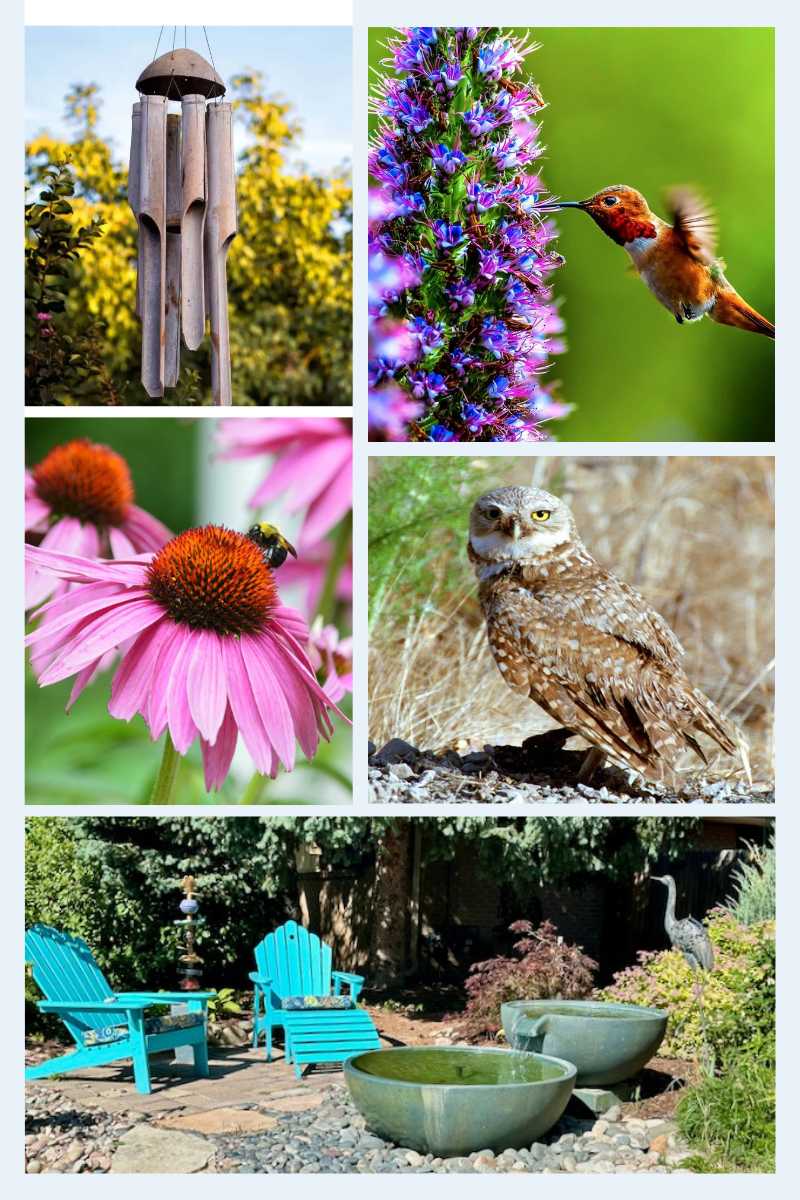
Next Steps and Resources
Are you ready to try xeriscaping? Even a small section of a yard can be turned into something unique and beautiful. I will share resources that allow you to see demonstration gardens and/or designs to see if something strikes your fancy.
Planning and Design
Many water companies and/or municipalities offer rebates for removing your lawn and replacing it with something using less water. It is easy to do an internet search of rebates by typing in your city with “xeriscape rebates available.”
In Colorado, SB23-178 was passed in 2023 that prohibits home owner associations (HOA) from denying a xeriscape design. In fact, there are many HOAs that are working with landscape design companies to create landscaping that reduces the amount of water used by the property through xeriscape. This is a win-win in my mind.
If you want to see examples of live xeriscape designs, many water companies list demonstration gardens to visit. The beauty of these destinations is you can see how different plants grouped together can create certain affects. Most of these gardens have plants labels near each plant which takes out any guess work.
One of the best free resources is the website Plant Select.org. At this site, you can search for plants and designs based on different themes. Do you want a “Native Pollinator Garden?” What if you only need ideas for a border area? There is a category called “Xeric Garden Border” that offers several plant options. Under the “Design” menu, if you select “Free Waterwise Landscape Designs,” you will have access to over fifteen free designs! If you select “Design Photo Gallery,” you will be treated to garden examples with vibrant colors.
Final Thoughts
I hope you will join me in transforming your outdoor space into an environmentally friendly and a beautiful multi-dimensional space. I have had the pleasure of speaking with many people who walk by my front yard and comment on numbers of bees, butterflies, hummingbirds and plants that they see in my space.
If you already have a space created with xeriscape principles mentioned above, please share photos in the comment section so our Earth Matters Now community can share in your creation. Do you have a favorite plant for your space? Please share!
Resources
Websites with free designs:
Denver Botanical Gardens
Denver Water Xeriscape Plans
Garden in a Box (great resource for beginners)
National Wildlife Federation
People & Pollinators Action Network
Plant Select.org
Waterwise Yards
Books that helped me:
Durable Plants for the Garden
The Aromatherapy Garden
Xeriscape Plant Guide
HOA information:
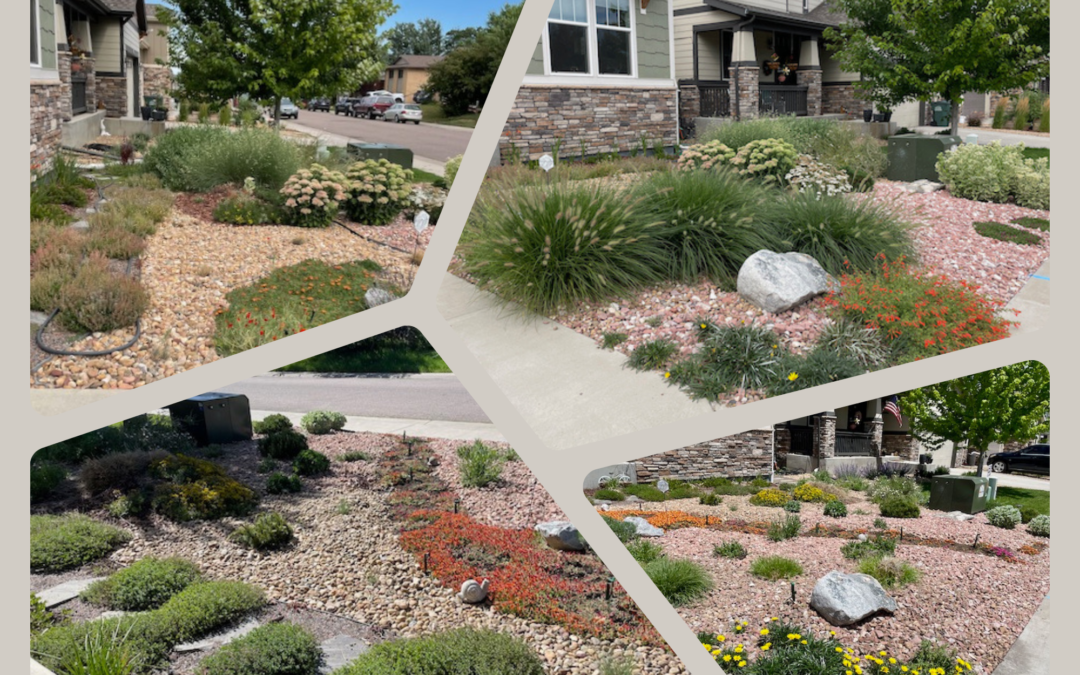
It excited my senses just reading this blog! I live in an apartment with a small north-facing balcony so only have a couple of plants, but I enjoy their beauty and fragrance everyday.
In California, we have the website calscape.org that has helpful information about native plants for your area. CA does not have the same CO 2023 law for HOAs, so that is great to know there is model legislation that CA could use! Thanks for that.
Great story! You referred to all the senses. Wonderful pictures. Further, you referenced several websites.